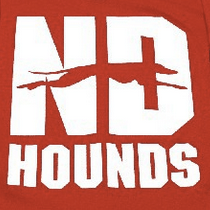
Each of the 2015 Stanley Cup finalist teams have two men who have something in common, other than the desire to win the Cup and have their name engraved on the championship trophy! Each has lived in the tiny village of Wilcox, Saskatchewan, in Canada’s western prairies, attending a boarding school that’s been developing athletes, especially hockey players, for nearly 90 years. The students are called “Hounds” — their colours the red and white of Canada. And even though the school is officially called the Athol Murray College of Notre Dame after the charismatic priest who ran it until his death in 1975, it’s best known as “Notre Dame College”, or, more simply, as “Notre Dame”.
Braydon Coburn
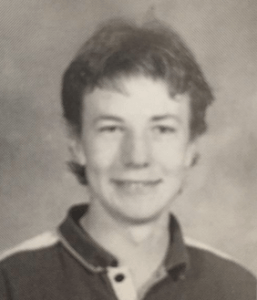
The Tampa Bay Lightning have two men on their payroll who are Hounds, but just one of those is a player. That’s 30-year old defenceman, Braydon Coburn (#55).
Though Coburn was born in the city of the Flames, in Calgary, Alberta, he grew up a three hour drive from Wilcox in the town of Shaunavon, Saskatchewan — which is also the hometown of women hockey’s superstar, five-time Olympic medalist, Hayley Wickenheiser.
Coburn went to Notre Dame for just two years, from 1999-2001, for Grades 9 and 10. In Grade 9, he did three things of note: he played football, took home a handful of academic awards and played hockey on the College’s Bantam AAA team, coached by Laury Ryan and Christian Twomey. At the end of that season, he was drafted 1st overall by the WHL’s Portland Winterhawks in the 2000 Bantam draft.
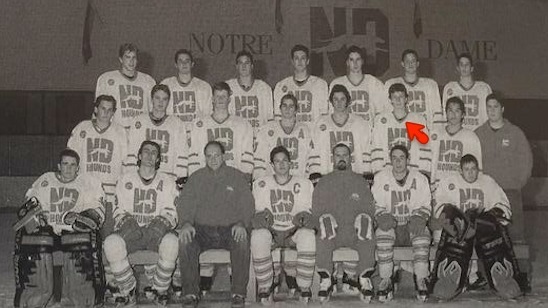
Coburn returned to Wilcox the following year to play Midget AAA hockey for the Hounds, co-coached by three-time Canadian hockey Olympian and bronze medal winner, Terry O’Malley, and Scot Owens. That team played in the invitational Midget AAA Mac’s Tournament in Calgary in 2001, a year when Zach Parise (#11, Minnesota Wild) was a second year Midget playing for Minnesota’s Shattuck-St. Mary Sabres — he was named both MVP and Top Scorer of the tournament.
Coburn made the Winterhawks’ roster starting in 2000-01, where he went on to play out his Junior days. He also represented Canada twice in the World Juniors, winning gold in 2005 and silver in 2004. Drafted 8th in the first round in the 2003 NHL Entry Draft by the Atlanta Thrashers (now the Winnipeg Jets). In July, 2004, he was signed by the Thrashers, but it took until October 5, 2005 before he finally stepped on the ice wearing an NHL uniform. After nine games, he was sent back down to their AHL farm team, the Chicago Wolves.
In 2006, Coburn played 29 games for the Thrashers and then, in a trade that Sportsnet chronicles as one of the most regrettable trade deadline deals ever, he was traded to the Philadelphia Flyers. He stayed with the Flyers until he was acquired by the Tampa Bay Lightning in time for the 2015 Playoffs — just before the 2015 NHL trade deadline.
Jon Cooper
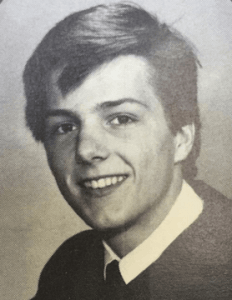
Forty-seven-year-old coach, Jon Cooper is the second Tampa Bay Lightning Hound. Cooper, who hails from Prince George, B.C., has been the Bolts’ coach since March 25th, 2013.
Cooper went to Notre Dame from 1982-85 where he completed his last three years of high school. While there, he ended up on a recreational hockey team called the Olympians (in the Father David Bauer League), coached by Greg Schmaltz.
Since the winters in Saskatchewan are bitterly long, especially if you’re not on the ice 4 to 6 times a week like the top players, are, Cooper wanted to be active and became the trainer for Terry O’Malley’s Midget AA team. It was a team on fire, winning the regional championships, the provincial championships and then a berth in Canada’s national midget AAA championships, the Air Canada Cup. Although the team played hard, they lost out to the host team, winning silver in the finals.
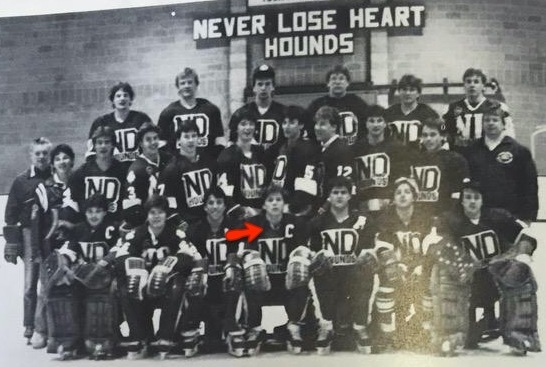
In Grade 12, Cooper wore the “C”, captaining Notre Dame’s Juvenile hockey team coached by Mike Sitko. He MC’d his class’s graduation ceremonies, and was soon off to Long Island, NY, where he was given an athletic scholarship from Hofstra University, for lacrosse!. Cooper earned a Bachelor of Business Administration while playing (and lettering in) lacrosse — and, guess what? He played club hockey too.
After Hofstra, Cooper studied law at the Thomas M. Cooley Law School at Western Michigan University in Lansing, Michigan. A judge he knew asked him if he’d coach his son’s high school hockey team, and Cooper said yes, and got the coaching bug really bad.
It would be easy to say “the rest is history” but it took a lot of courage and years to of hard work to get to where he is now, behind the bench for the Bolts. He abandoned practicing law to follow his dream of hockey, going from the NAHL to the USHL, the USHL to the AHL and finally the AHL to the NHL, coaching teams with names like that Bandits, the Gamblers, the Crunch and the Admirals before being asked to lead the Bolts. “Never Lose Heart, Hounds” is one of the College’s inspirational sayings, and it’s exemplified by Cooper’s quest for a top-tier coaching career.
Scott Darling
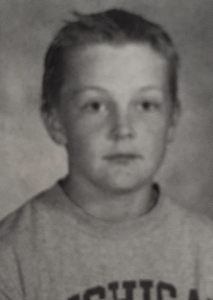
Our first Chicago Blackhawks Hound is 26-year-old backup goalie, Scott Darling (#33), who grew up in the Chicago suburb of Lemont, Illinois. Darling attended Notre Dame from 2002-03, when he was in Grade 8. He goaltended the College’s Bantam AAA team, coached by long-time Hounds, Dennis Ulmer and Bill Gibson.
Before becoming an NHL player, Darling had to overcome some personal struggles and refocus his life if he was ever going to achieve his goal as a hockey player, which he did. Despite staying at Notre Dame for just one year, the impact the College had on him is evident each and every time he
gets on the ice for Chicago. His custom-painted goalie helmet has the College’s latin motto, “Luctor et Emergo” painted on the back. Translated, the motto means “Struggle and Emerge”.
In a 2014 interview with Puck Junk, Darling said, “The motto stuck with me, so I got it on my mask. And it ended up being very accurate for me.”
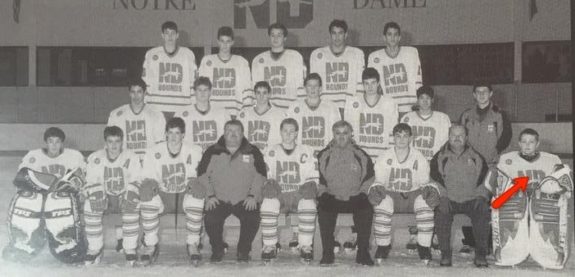
Brad Richards
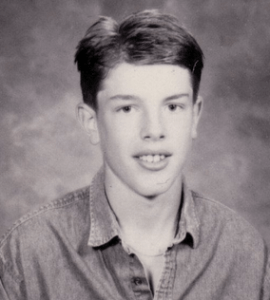
The second Chicago Blackhawks Hound, wearing #91, is 35-year old center, Brad Richards. Richards came to the College from Canada’s eastern shore, 2,500 miles east of Wilcox, from Murray Harbour, Prince Edward Island. Richards spent his first three years of high school at the College, from 1994-97, and two of those three years he roomed with future NHL teammate, Vincent Lecavalier, from L’Île-Bizard, QC.
Richards and Lecavalier played two years of Bantam AAA together, one year coached by Terry O’Malley and the second by Dennis Ulmer. As well, both played for O’Malley’s Midget AA team for the playoffs.
With the 2nd year Bantams, Lecavalier scored 120 points in 20 games; Richards scored only 97 (mainly because he played defence part of the time). Despite those amazing numbers, neither of them were the leading scorers on the team. That honour goes to a student that came from Switzerland who ended up playing for the Swiss Men’s National Hockey Team, Jan Cadieux, who scored 122 points! Needless to say, when this one line was averaging 6 points per game, the team won the championship.
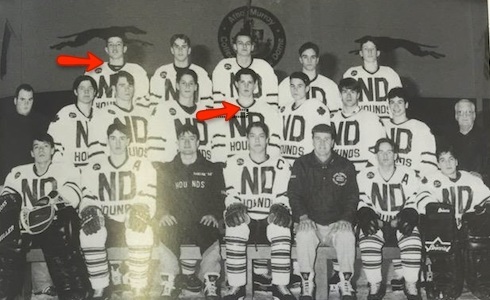
Lecavalier, now playing for the Philadelphia Flyers, was instrumental in Richards’ being drafted by the Lightning in the 1988 NHL Entry Draft. Lecavalier, who went as the 1st pick, suggested Richards to the Lightning management and he was picked, 64th overall, in the 3rd round. The two have done a lot together since their time at Notre Dame: they both played for the Rimouski Oceanic in the Quebec Major Junior Hockey League, they both won the Stanley Cup playing for the Lightning in 2004, they both played for Ak Bars Kazan in Russia during the 2004-05 NHL lockout, and they both appeared in a 2006 NHL ad, claiming Lecavalier and Richards are “Just Like You“. And one more thing. They both got traded.
The Lightning traded Richards to the Dallas Stars in 2007, and, as an unrestricted free agent, he eventually ended up with the New York Rangers. The Rangers bought out the remaining 3 years of his 9-year contract at the end of June, 2014 and a week later, Richards signed a 1-year contract with the Chicago Blackhawks.
Retaining the Great Players
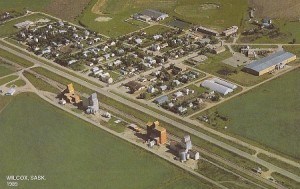
Of the four Hounds on the Stanley Cup finalist teams, only one, Jon Cooper, graduated from the College. The great players mentioned in this article — Coburn, Darling, Lacavalier and Richards — were all lured away. I asked the Director of Hockey Development, Del Pedrick, about this, and how Notre
Dame is now helping to make sure these kids succeed academically.
“Our ultimate goal at Notre Dame is to retain all student athletes through to graduation,” says Pedrick. “However, many of the student athletes themselves have goals to move forward with hockey and to play Major Junior hockey with the WHL, OHL, QMJHL or USHL. If this is their decision, we’ll
work with them to find the right fit, and encourage them to be a part of our Return to Graduate Program that sees players returning after their hockey season ends to finish schooling.”
Pedrick says that several Hounds are participating in this program, a win-win for both the College and the player.
“Ultimately the Notre Dame Hockey Program prides itself in developing each student athlete to the best of their potential both on and off the ice,” Pedrick explains. “That includes working to promote them to the next level
when they are ready.”